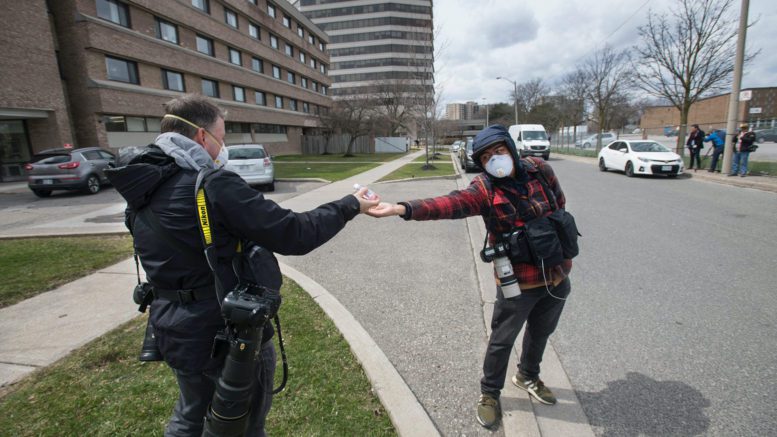COVID-19 has pushed photojournalists to use their creativity and skills to tell a visual story at a distance amid complicated challenges during these extraordinary times. The implementation of social distancing guidelines has made it difficult for photojournalists to perform their work consistently and effectively.
Freelance photographer Carlos Osorio said it is an arduous process as he has to maintain social distancing guidelines and sanitize his camera equipment before and after work. Before he captures photographs in the field, he has to prepare personal protective equipment such as gloves, face mask and hand sanitizer. After Osorio finishes taking photographs, he sanitizes not only his camera equipment but he also puts on a new change of clothes.
“All my cameras get cleaned in here after every assignment every time I go out,” Osorio told The Toronto Observer in an interview in late June. “I come home, I go wipe everything down with Lysol wipes, and then I basically just lay it out on the floor because it has to air dry. And once I do all that, I clean my hands.”
When it comes to regular assignments, Osorio said he was able to respect social distancing by utilizing a longer lens. But he said it is impractical to keep his distance when it comes to photographing protests.

“It’s impossible to maintain social distance, because a lot of the times we want to be present,” Osorio said. “So, is it a risk? Sure, but you just try and do the best you possibly can to protect yourself and still be able to do your job.”
Osorio, who previously worked as a staff photographer for the Toronto Star, compared his experience as a freelance photographer to being on staff for a major newspaper. In the latter, staff photographers have benefits, use company equipment and receive a steady salary. Despite the benefits, Osorio said that being a freelance photographer provides him with more creative freedom in his work. However, he has found the pandemic has decreased the demand for freelance photographers.
Evan Mitsui, a staff photographer for CBC’s The National, said the amount of work has increased for him as there is a need for journalist to cover news stories about COVID-19.
“I think it’s safe to say I’ve never been so busy. My workload has grown exponentially because of the pandemic,” Mitsui told The Toronto Observer in a recent interview. “I’ve been really fortunate to be able to be out working, not just working consistently, but working a lot every day. And it’s also given me a lot of freedom to pitch stories and chase things.”
Fred Lum, a staff photographer for The Globe and Mail for 36 years, said financial security is the main benefit for staff photographers but that jobs in journalism are disappearing.

“Staff jobs are in decline and have been for years, and they likely won’t ever be filled,” Lum told The Toronto Observer. “I’m the only staff photographer at the Globe, although the video department also fills in if the day gets busy.”
The biggest challenge that journalism currently faces is the multitude of layoffs and furloughs. The increasing amount of budget cuts has made news organizations experience financial struggles. Some have faced suspension of work operations, while others have faced closure, making the future of journalism filled with obstacles and uncertainties.
Osorio hopes news organizations will find new ways to succeed, but he is uncertain about what journalism jobs will look like. Mitsui says local news organizations are struggling but finds that the push from COVID-19 has firmly continued the surge of online news platforms. As for print, Lum believes that stories in newspapers will have to depend on affordability, but also finds it to be an invaluable source of information that will always be around.
When asked for advice for aspiring journalists, they all said they believe in hard work and being relentless when digging for stories. As for photojournalists, it’s all about building the skills needed for today’s changing world.

